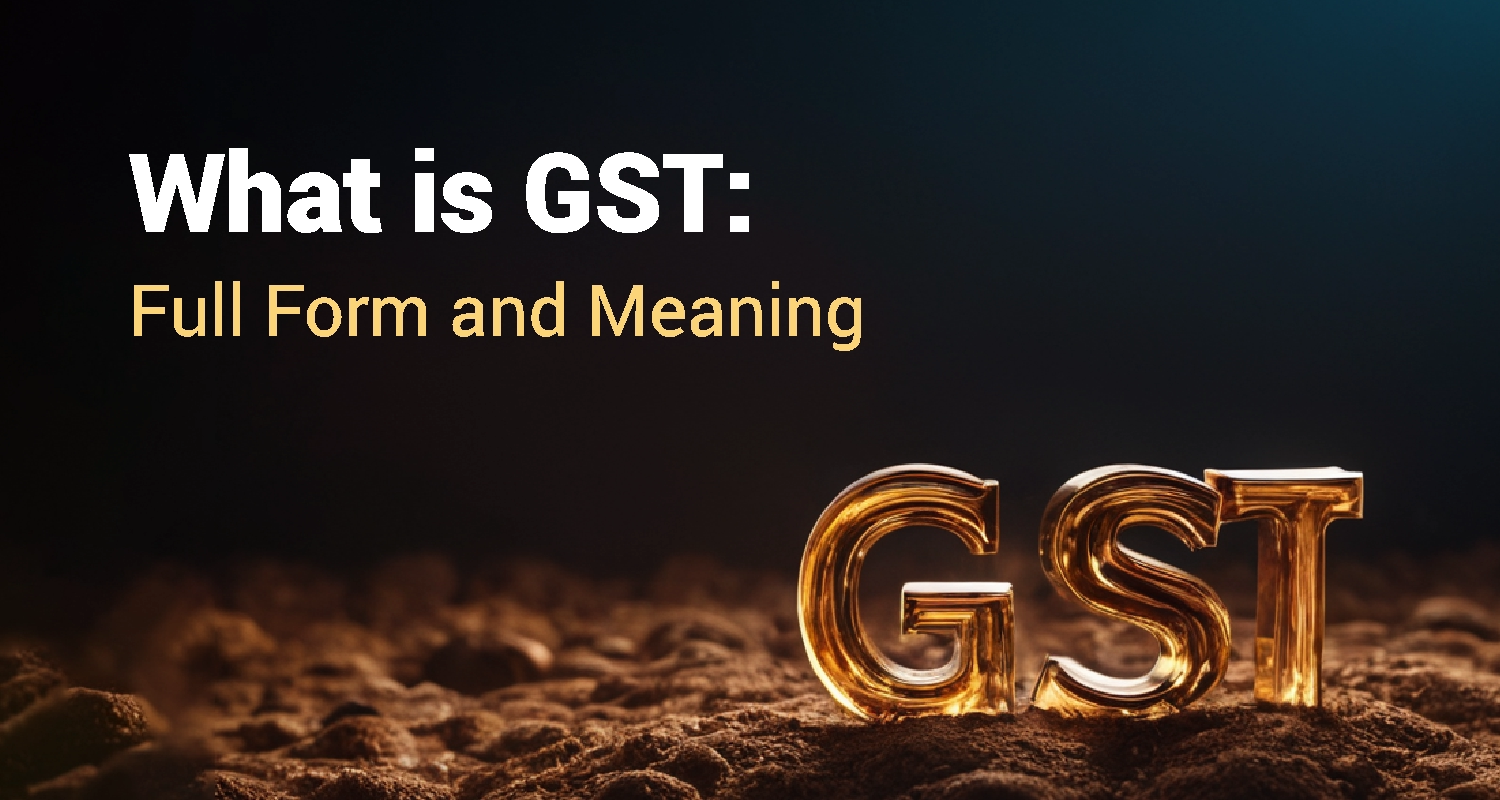What is GST: Definition, Types, and How It's Calculated?

Understanding the Goods and Services Tax (GST) is essential for anyone engaging with the Indian economy, whether as a consumer or a business owner. This article explains GST's significance and impact on various stakeholders.
What is GST?
GST full form is Goods and Services Tax, which is a comprehensive tax levied on the supply of goods and services in India. It was introduced to streamline and simplify the country's indirect tax structure.
On the other hand, GST meaning in Hindi can be understood as "वस्तु और सेवा कर" (Vastu aur Seva Kar), which serves the same purpose of creating a unified tax system across the country.
Let’s break down the components:
- Goods: Tangible items that are sold in the market.
- Services: Intangible offerings are provided for a fee.
- Tax: A compulsory financial charge imposed by the government.
History of GST (Goods and Services Tax) In India
The journey of Goods and Services Tax (GST) in India began over two decades ago. It was first proposed in 2000 by the Vajpayee government, which formed a committee to draft the GST model.
After years of consultations and debates, the Constitution (122nd Amendment) Bill was passed in 2016, paving the way for a unified tax regime. GST was officially implemented on July 1, 2017, replacing multiple indirect taxes like VAT, service tax, and excise duty. Its introduction marked a major milestone in India’s tax reform, aiming to simplify taxation, improve compliance, and create a unified national market.
Objectives of GST in India
The objective of GST is to streamline India's taxation system by replacing multiple indirect taxes with a unified structure. Introduced on July 1, 2017, GST aimed to eliminate complexities in the tax regime, ensuring better compliance and efficiency. Key objectives include:
1. Simplification: Creating a Single, Unified Tax Structure
Prior to GST, India's indirect tax system was fragmented, with multiple taxes like VAT, service tax, and excise duty levied by different authorities. GST consolidated these into a single tax, streamlining the tax structure and reducing compliance burdens for businesses. This unification has made tax administration more efficient and has simplified the overall tax process for taxpayers.
2. Transparency: Enhancing Clarity of Tax Obligations
GST's implementation introduced a transparent tax system by digitizing processes such as registration, return filing, and payments. The use of the Goods and Services Tax Network (GSTN) ensures that all transactions are recorded and monitored, reducing the scope for tax evasion and fostering trust among taxpayers.
3. Increase in Revenue: Broadening the Tax Base and Improving Compliance
By bringing more businesses into the formal economy and reducing tax evasion through stringent compliance measures, GST has expanded the tax base. The uniform tax rates and input tax credit mechanism encourage voluntary compliance, leading to increased revenue collection for both central and state governments.
4. Boosts Economy: Enhancing Transparency, Reducing Tax Leakages, and Improving Revenue Collection
The elimination of the cascading effect of taxes under GST has reduced the overall tax burden on goods and services. This, combined with improved compliance and reduced tax leakages, has contributed to a more robust and transparent economy, fostering growth and stability.
5. Simplifies Business: Streamlining Tax Structure and Minimizing Operational Complexities
GST has simplified the tax regime by replacing multiple indirect taxes with a single tax, thereby reducing the complexity of tax compliance for businesses. This simplification has particularly benefited small and medium enterprises (SMEs) by lowering compliance costs and making it easier to operate across different states.
6. Facilitates Trade: Ensuring Smooth Inter-State Movement of Goods and Services
The introduction of GST has removed inter-state barriers to trade, such as entry taxes and check posts, facilitating the seamless movement of goods across state borders. This has led to a unified national market, enhancing the efficiency of supply chains and reducing logistical costs.
7. Enables Online Compliance: Simplifying Registration, Returns, Refunds, and E-Way Bills
GST has embraced digitalization by enabling online processes for registration, filing returns, claiming refunds, and generating e-way bills. This digital approach has made compliance more straightforward and accessible, reducing paperwork and saving time for taxpayers.
Types of GST in India
GST in India is categorised into three types:
1. CGST – Central Goods and Services Tax
CGST is levied by the Central Government on intra-state supplies of goods and services. It is collected along with SGST by the state where the transaction occurs. The revenue from CGST goes to the Centre and ensures that the central share of tax is maintained in domestic transactions within a state.
2. SGST – State Goods and Services Tax
SGST is imposed by the State Government on goods and services sold within the state. It is collected alongside CGST on intra-state transactions. The revenue from SGST goes directly to the respective state government, ensuring state-level tax administration continues under the new GST regime.
3. IGST – Integrated Goods and Services Tax
IGST is charged on inter-state transactions of goods and services and on imports. It is collected by the Central Government and then shared between the Centre and destination state. IGST ensures seamless tax credit flow across states and eliminates the need for multiple state entries and tax complications in inter-state commerce.
How Does GST Work?
GST operates on the principle of value addition, meaning that tax is paid only on the value added at each stage of production or distribution. Here’s how it typically works:
- A manufacturer pays GST on raw materials.
- When the manufacturer sells the finished goods, they charge GST to the retailer.
- The retailer pays GST on their purchase while collecting GST from the consumer.
- Each party can claim an input tax credit for the GST paid on purchases.
Sapna aapka. Business Loan Humara.
Apply NowBenefits of GST
The following are key benefits of GST to different segments:
For businesses
- Ease of Compliance: A unified tax system reduces the complexity of compliance.
- Input Tax Credit: Businesses can reclaim the GST paid on purchases, lowering overall tax liability
For consumers
- Lower Prices: The cascading effect of taxes is eliminated, often resulting in lower prices.
- Transparency: A clear tax structure leads to better understanding and trust.
For the government
- Increased Revenue: A broader tax base leads to higher revenue collection.
- Less Tax Evasion: The digital tracking of transactions reduces the chances of tax evasion.
How Has GST Helped in Price Reduction?
GST has contributed to price reduction mainly by eliminating the cascading effect of taxes. Earlier, taxes were levied on top of other taxes, inflating the final cost of goods and services. Under GST, businesses can claim input tax credit across the value chain, which reduces the overall tax burden.
Additionally, the rationalization of tax slabs and unified rates has curbed hidden taxes. This streamlined structure has improved efficiency in the supply chain and reduced logistics costs, leading to more competitive pricing. Consumers now benefit from fairer prices, especially on essential goods and commonly used services.
GST Rates and Categories
GST is divided into tax slabs:
|
Rate |
Category |
|
0% |
Essential goods like fresh food and books |
|
5% |
Packaged food, public transport |
|
12% |
Processed food, mobile phones |
|
18% |
Electronics, telecom services |
|
28% |
Luxury goods like cars and tobacco |
GST Registration and Compliance
Businesses with a turnover exceeding a specific threshold must register for GST. Upon registration, they receive a unique GSTIN (Goods and Services Tax Identification Number). Compliance involves regular filing of returns and maintaining proper records.
Common Misconceptions About GST
The following are common misconceptions about GST:
- GST is a new tax: GST is not a new tax but rather a consolidation of existing taxes.
- All goods are taxed at the same rate: Different goods and services attract different GST rates.
- Only businesses need to worry about GST: Consumers also contribute to GST through purchases.
Conclusion
GST has transformed the tax landscape in India, making it more straightforward and efficient. By understanding GST, businesses and consumers can navigate the tax system more effectively. This unified tax not only simplifies compliance but also promotes economic growth.
FAQs
Q1. What is the main purpose of GST?
Ans. The main purpose of GST is to simplify the tax structure and eliminate the cascading effect of multiple taxes.
Q2. How is GST calculated?
Ans. GST is calculated on the taxable value of goods and services at rates specified by the government.
Q3. GST Meaning in English?
Ans. The GST meaning in English is straightforward: it refers to a unified tax system that applies to goods and services alike.
Q4. Do all businesses need to register for GST?
Ans. Not all businesses must register; it depends on their turnover and the nature of their operations.
Sapna aapka. Business Loan Humara.
Apply NowDisclaimer : The information in this blog is for general purposes only and may change without notice. It does not constitute legal, tax, or financial advice. Readers should seek professional guidance and make decisions at their own discretion. IIFL Finance is not liable for any reliance on this content. Read more



